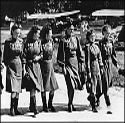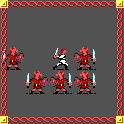|
Twat McTwatterson posted:Details on Roman involvement in Arabia? Coined Arabia Felix, I believe. Felix meaning lucky, but why this term? Arabia is largely, if not entirely, nomadic tribes until Mohammed in the 7th century- if Islam is of the Abrahamic tradition, was that tradition brought to Arabia by Jews as a result of the diaspora? What is the earliest date of Judaism in Arabia? There must be some Jewish involvement... There where at least some Jews in Mecca before the advent of Islam. Arabia Felix is what is now Yemen, and was a major trade route stopping point. My favorite random Mohammed story is there was at least at one, a letter sent to the Emperor Heraclius saying basically "convert or invade". Making it one of the few times a major religious figure had some historical documentation.
|
|
|
|

|
| # ? Apr 28, 2024 20:35 |
|
sbaldrick posted:There where at least some Jews in Mecca before the advent of Islam. Arabia Felix is what is now Yemen, and was a major trade route stopping point. There has been in a significant Jewish population in the Middle East all the way up until modern Arab Nationalism and the rise of Israel. Much of early Islamic history has to do with Muslims dealing with Jewish tribes, which were firmly established in the Bedouin regions.
|
|
|
|
Did the Romans actually die/paint the armor, shields, and clothes of their troops red?
|
|
|
|
Farecoal posted:Did the Romans actually die/paint the armor, shields, and clothes of their troops red? Usually not. Dye was very expensive. Although the higher-ups, such as centurions and other officers, did have dyed cloaks to help signify rank and generally had more money to purchase dye. This actually inspires me to give a little bit of a rundown into the equipment Roman soldiers usually carried. I'm really into the Roman Army and their equipment is rather fascinating. While on the move the Legionary could carry between three days and two weeks' worth of rations, some sort of saw, a wicker basket, a length of rope or leather, a shovel, a waterskin, a sickle and a pickaxe. Each of these items, aside from the pickaxe (worn on the belt), was carried on a large pitchfork introduced by Marius called the pila muralia, which earned his men the nickname Marius' Mules. We're still not entirely sure what was actually carried by each soldier. Some items were probably transported in wagon trains or on mules such as tents and millstones for grinding the corn rations. We do think that a typical grunt carried anywhere from 70-100 pounds. The Typical Roman Soldier Carried: Buccellatum and Frumentum: Hard tack and corn rations. Didn't go bad and easy to prepare. We see these kinds of rations until well past the American Civil War. Papilio: Leather tent. Stakes included.  Tunica: The standard tunic worn over the underwear (which were linen) and underneath his armor. Bracae: Fun Fact: Romans considered the wearing of pants to be against any standard code of dress. However, legionaries in cold climates were allowed to wear wool or leather skin tight trousers that reached just below the knee (provided they could afford them) Caligae: Heavy sandals that used iron nails as treads, similar to cleats. The leather strap continued half way up the shin and was tied, and in cold weather could be stuffed with wool or fur or whatever.  Cingulum Militare: Belt. Was rather narrow and decorated with bronze, and were sometimes tin-plated all the way around to help in durability  Focale: Scarves worn to prevent their armor from scraping their necks. Galea: Helmet. There were a bunch of types of galea but this was the most common helmet. They were generally made of bronze with iron trim, with a projecting piece to guard the neck and a smaller ridge fastened at the front for protection of the face. At the sides were large cheek pieces hinged at the top.  Sporran: An apron-style garment, consisting of leather straps to which metal plates were fastened. It could have been either decorative or protection for the genitals. We assume the latter. Scutum: A large shield curved to fit the body. They were made from thin sheets of wood, glued so that the grain of each piece was at right angles to the piece next to it. The whole was bound around the edges with iron or bronze (usually iron) and the center was hollowed out for the handgrip and protected by metal bands. The outside surface was covered in leather, which had gilded or silvered decoration made from bronze. Each cohort had different color schemes to help with recognition during a battle. The shields also carried the name of the soldier and that of his centurion. On the march, the shield was hung by a strap over the left shoulder.  Body Armor: Other goons have already gone over these so I won't recap. They probably know more about it than I do. Weapons Gladius: The Roman short sword, adopted from the Iberians. It was a double-edged weapon about 18 inches long and two inches wide, often with a grip formed to the soldier's hand. A large round ball at the end helped with balance. Mostly used for thrusting at short range. It was carried high on the right hand side so as to be clear of the legs and the shield arm.  Pilum: Javelin. It was seven feet long and very light, as it was thrown just prior to engaging the enemy in melee, to disarm as much as hurt the enemy. The top three feet were made of iron with a hard point. More sturdy spears for engaging cavalry in the Testudo were likely but we can't be certain.  Pugio: Roman dagger about 7 to 11 inches long and as wide as the gladius. It could be either decorative or plain (again, depending on wealth), but was a very good secondary weapon in case of being disarmed. It was attached to the belt on the left hand side.  Centurion Gear A centurion's equipment was notably different from that of a legionary. He wore a crest along his helmet that would serve as an easily recognized point of reference for the men. The crest was made of feathers or horsehair and colors could signify various ranks. If I remember right, they would usually wear chain or scale (somebody correct me here, I'm not sure). The armor and helmet was sometimes silver-plated. He did not wear an apron but had a double-pleated kilt like piece. They also wore a cloak, of fine material, which hung from the left shoulder and a very ornate belt. Additionally the wearing of bronze greaves on the shins set them apart from the rank & file. They generally wore their swords on the left and daggers on the right, opposite of the common soldiers. He often carried a Vitis, or a vined staff, in his right hand as a symbol of his rank. It was made of grapevine and about 3 feet long.  Officer Gear Officers often dressed very differently from anyone else and there seems to be set pattern to the styles. They had very fine dyed cloaks of various colors to signify rank. They generally wore a muscled cuirass and used a parazonium instead of a gladius. Lorica Musculata: The muscled cuirass was a bronze chest piece made in two pieces, one for the front and one for the back, and buckled together at the sides. These were well decorated with animal, mythological and chest muscle designs.  Pteruges: Straps that hung off the shoulders and waist and covering the upper arms and legs, were made of leather. They were implemented to protect the arms and legs, while conserving the use of metal. Parazonium: The more ornate sword carried by officers, the hilt of which could be in the form of an eagle head or something similar. Most often cradled in the left arm, and the fingers of the left hand can be forked over the lobed pommel.  Apologies for the quality of the images, GIS basically just gives me a bunch of reenactment pictures. HOTLANTA MAN fucked around with this message at 23:41 on Jun 5, 2012 |
|
|
|
So did the helmets really scratch / leave marks/indentations under the chin of the wearer?
|
|
|
|
Opinions on the Robert Fagles translations of The Illiad/Odyssey and The Aeneid?
|
|
|
|
|
TEBOW 3 16 posted:Pilum: Javelin. It was seven feet long and very light, as it was thrown just prior to engaging the enemy in melee, to disarm as much as hurt the enemy. The top three feet were made of iron with a hard point. More sturdy spears for engaging cavalry in the Testudo were likely but we can't be certain. The most interesting part of the pilum was it's soft iron neck. The reason it is so thin in this picture is because that way the shaft would bend if it hit anything besides a soft body. This would then render a shield useless or at least extremely cumbersome as you now have a 7 foot spear stuck in your shield. It also prevented them from being throw back at the legions. Each legionary was given two of them, one weighted and the other not, the idea behind weighting them was to add more penetrating power and to facilitate bending the iron shaft. Farecoal posted:Did the Romans actually die/paint the armor, shields, and clothes of their troops red? After Marius, yes, red was a relatively cheap color to make since it came from Madder, a common plant in Europe and he Mediterranean. Crimson, Indigo, Saffron Yellow and especially purple were far more expensive. Purple was so expensive only the emperors could afford to wear it, and it is associated with royalty in other cultures as well for that reason. Soldiers after Marius were supplied by the state since he did away with the money and property requirements to join the legions. The soldiers were given at least one tunic, possibly two, as well as their armor, boots/sandals, weapons and other equipment. The soldiers could buy additional stuff, and there is evidence of them buying things like armor for armor for their arms and such. WoodrowSkillson fucked around with this message at 05:47 on Jun 6, 2012 |
|
|
|
WoodrowSkillson posted:The most interesting part of the pilum was it's soft iron neck. The reason it is so thin in this picture is because that way the shaft would bend if it hit anything besides a soft body. This would then render a shield useless or at least extremely cumbersome as you now have a 7 foot spear stuck in your shield. It also prevented them from being throw back at the legions. Each legionary was given two of them, one weighted and the other not, the idea behind weighting them was to add more penetrating power and to facilitate bending the iron shaft. What did the dyes represent? I've always seen / understood red as the Armies, but heard that the Navy used Blue for it's soldiers.
|
|
|
|
Iseeyouseemeseeyou posted:What did the dyes represent? I've always seen / understood red as the Armies, but heard that the Navy used Blue for it's soldiers. I don't know a ton much more about it, I know that blue was made from woad which is a common plant as well, which would make that idea of blue being used by sailors perfectly plausible. It was common enough that a bunch of the tribes Caesar conquered would use it to dye their bodies a la Braveheart. Indigo was separate as it was made using far more expensive stuff and mostly all came from India, hence the name. I think there was color coding in the single stripe on the togas as well, but it escapes me at the moment, its late here and I need to go to bed. Red was not exclusive to the army either, Madder was used for a bunch of stuff. Kinda like how police mostly wear blue, and are nicknamed the "boys in blue" but its not like its The Cop Color and blue shirts are associated with law enforcement.
|
|
|
|
So, OP. Optimas, or Popularis?
|
|
|
|
Rykert posted:So, OP. Optimas, or Popularis? Optimus or Popularis, please. But either way, in the end it had little to do with policies and more to do with the means by which politicians got their power and stuff pushed through. Populares weren't necessarily more progressive or anything the way we'd like, but they used the Tribunes of the People to push stuff through that they couldn't get through the Senate. That's the distinction. It's still elites battling elites for power, either way. (There are some "good" policies that they'd put through, but it's all political machination, not ideology)
|
|
|
|
WoodrowSkillson posted:I don't know a ton much more about it, I know that blue was made from woad which is a common plant as well, which would make that idea of blue being used by sailors perfectly plausible. It was common enough that a bunch of the tribes Caesar conquered would use it to dye their bodies a la Braveheart. Indigo was separate as it was made using far more expensive stuff and mostly all came from India, hence the name. I think there was color coding in the single stripe on the togas as well, but it escapes me at the moment, its late here and I need to go to bed. If I am not mistaken, purple was also used to color the togas of important men like senators and priests. The expensive purple (Tyrian) came from a specific mollusk off the coast of Lebenon.
|
|
|
|
We only know a fraction of what there is to know about the Roman army, and next to that our knowledge of their navy is negligible. Which is a shame, because they were responsible for some of the most pivotal victories in Roman history. For example it's a good guess that there was a 50/50 split between ocean and river operations, but we know even less about their river activities. One thing that can be said with relative certainty is that the popular image of the slave galley is a myth. Their fleets were free soldiers and paid professionals that enlisted by the tens of thousands. I'm not sure what they wore (probably not much belowdecks).
|
|
|
WoodrowSkillson posted:I think there was color coding in the single stripe on the togas as well, but it escapes me at the moment, its late here and I need to go to bed. Ordinary men used a plain white toga (toga virillis), consuls wore togas with a purple trim, people who were candidates wore a bleached toga, people who were in mourning wore grey or brown togas and finally prostitutes were the only women that wore togas.
|
|
|
|
|
Alhazred posted:Consuls wore togas with a purple trim, people who were candidates wore a bleached toga. The English word "candidate" actually comes from that practice, as "candida" is (I think)Latin for "white."
|
|
|
|
Twat McTwatterson posted:Details on Roman involvement in Arabia? Coined Arabia Felix, I believe. Felix meaning lucky, but why this term? Arabia is largely, if not entirely, nomadic tribes until Mohammed in the 7th century- if Islam is of the Abrahamic tradition, was that tradition brought to Arabia by Jews as a result of the diaspora? What is the earliest date of Judaism in Arabia? There must be some Jewish involvement... Arabia Felix refers to what is basically modern Yemen, not all of Arabia; it was so named because it was quite fertile (owing to widespread irrigation mostly) and was home to several sedentary kingdoms (Qataban, Ma'in, Hadramawt, Saba') which grew very wealthy off of the trade in incense that ran along the Red Sea coast north to Nabataea (Jordan). Augustus actually sent out a campaign into the westernmost part of this region in 25 BC (IIRC), but didn't accomplish much and withdrew fairly quickly. I can't specifically answer the Abrahamic tradition part, but the earliest evidence for Judaism in Arabia comes (again) from Yemen (which basically was the only area of Arabia to develop large-scale urban civilization in antiquity) and comes from the first centuries AD, I believe. There was actually a Jewish Himyarite kingdom in Yemen during the 6th c. AD.
|
|
|
|
Iseeyouseemeseeyou posted:What did the dyes represent? I've always seen / understood red as the Armies, but heard that the Navy used Blue for it's soldiers. What colours were commonplace for the military clothing of different divisions of the army is actually a controversial topic among scholars and reconstructors. It is generally accepted that navy soldiers wore blue tunics, but there isn't a whole lot of evidence for that. For legionaries the most common colours were red, whitish, and natural brownish colours (undyed).
|
|
|
|
I just discovered that the early Popes and Roman emperors co-existed? How did that work? I also discovered there was a pope named Pope Hilarius
|
|
|
|
physeter posted:We only know a fraction of what there is to know about the Roman army, and next to that our knowledge of their navy is negligible. Which is a shame, because they were responsible for some of the most pivotal victories in Roman history. For example it's a good guess that there was a 50/50 split between ocean and river operations, but we know even less about their river activities. The navy gets shortchanged even in Roman histories. Romans never saw themselves as much of a sea power, they would tend to build up the fleet when they needed it and then let it atrophy when they didn't. The early Roman innovations were all ways to grab an enemy ship so you could send over marines, thus bringing Rome's land fighting advantages onto the water. The ships were rowed by soldiers/sailors, yes. No slave galleys. By far the coolest thing was the invention of Greek fire, which was used by the medieval Romans to devastating effect. If you saw the second to last episode of Game of Thrones you will have an idea. Roman ships would have a hand-pumped flamethrower mounted on them to hurl Greek fire at an enemy ship, which would set it aflame and was nearly impossible to put out. Your only option was to smother it in sand or, strangely, they said peeing on it would put it out. Lots of speculation what chemical reaction might've been going on there, since we don't know the recipe--it was a closely guarded secret and has been lost. All the reports say that it would continue to burn in water. Given that all ships were wooden, there was really no defense against this and the Roman navy was unstoppable for a good long time. The Romans also used Greek fire in grenades and hand-portable flamethrowers, like so:  Fun fact, this was not the first use of flamethrowers. We have some records of fire grenades dating back to the 800s BCE and a description of Greeks using flamethrowers at the siege of Delium in 424 BCE. This Roman one is the first portable one that functioned like a modern flamethrower. Farecoal posted:I just discovered that the early Popes and Roman emperors co-existed? How did that work? The Pope having massive power didn't really happen until later, as far as I know. It was actually a fairly short period of time where the Pope was on top of everything--they had a lot of authority for a long time, but not so much real power. Grand Fromage fucked around with this message at 03:15 on Jun 7, 2012 |
|
|
|
Grand Fromage posted:
Except, according to Wikipedia, the Popes were heads of the church before Christianity became the religion of the empire. The pope and emperor passing each other in the hallway must have been awkwarddddd Yeah, I know, that probably wasn't how it worked.
|
|
|
|
Farecoal posted:Except, according to Wikipedia, the Popes were heads of the church before Christianity became the religion of the empire. The pope and emperor passing each other in the hallway must have been awkwarddddd Ah yeah, that part. I don't know. I imagine the Pope wasn't running around in Pope gear getting all Popey.
|
|
|
|
I love Greek Fire so much. It was largely responsible for why the Romans were able to weather the storm of the Arab sieges of Constantinople during the 7th-8th centuries.
|
|
|
|
The pope is just the Bishop of Rome. His claim to lead all of the churches is quite controversial as you can imagine. The bishop of Rome being super Pope didnt happen until way later. And also the Emperor was never really in Rome much in the late empire. Anyway here is the first priest to win a showdown with an emperor: http://en.wikipedia.org/wiki/Ambrose quote:Theodosius I, the emperor of the East, espoused the cause of Justina, and regained the kingdom. Theodosius was threatened with excommunication by Ambrose for the massacre of 7,000 persons at Thessalonica in 390, after the murder of the Roman governor there by rioters.[1] Ambrose told Theodosius to imitate David in his repentance as he had imitated him in guilt — Ambrose readmitted the emperor to the Eucharist only after several months of penance . This incident shows the strong position of a bishop in the Western part of the empire, even when facing a strong emperor — the controversy of John Chrysostom with a much weaker emperor a few years later in Constantinople led to a crushing defeat of the bishop. euphronius fucked around with this message at 03:52 on Jun 7, 2012 |
|
|
|
Would anyone be so kind as to write a bunch of stuff about how the Eastern Romans basically got screwed by modern Western history? I know I'm hardly alone here when I say that I think the Medieval Romans fail to get even a fraction of the credit they deserve. But why is that?
|
|
|
|
I'm not sure I know enough to write a bunch of stuff, but there are three big reasons I can think of. First, written history in the west has a big gap in late antiquity, from the late 400s until the 800s. 800-1000 is a bit sketchy too, so that entire period ends up being called the Dark Ages and getting treated like poo poo in history. Soon after we have the schism of the church, the west and east move apart and, while still both Christian and nominally allied against the Muslims, they don't get along well. So western historians focus on the west and ignore Rome. Then, much later, more modern historians start calling it the Byzantine Empire and people think it's not Rome anymore, so it gets entirely divorced from Roman history in the common understanding of things. Plus little of the territory is now considered the west, which colors how people look at it.
|
|
|
|
My best quickly written summary of the hierarchy of the early Christian church. The early church had five people in charge, patriarchs of the principal Roman cities. These were the patriarchs of Rome, Constantinople, Antioch, Jerusalem, and Alexandria. This is a good marker of how Eastern in character Christianity was at its beginning and how important the East had become to Rome in general. Only one of those cities is in "Europe" west of the Bosporus. With Constantine came a tradition that the Emperor was in charge of the Church as a whole, so-called "Caesaropapism". With the conquest of three of the patriarchates by the muslims came the greater importance of the final two: Rome and Constantinople. When Roman power in Italy waned a little after the 8th century, the Patriarch of Rome got a bit uppity and started carving out his own personal fiefdom in the consciences of western European christians and their rulers. This was the office that came to be the Papacy. It's important to know that the Pope shouldn't be more important than the other four patriarchs, but various holders of the office of Patriarch of Rome aggrandized themselves through a bunch of absolute bullshit, including the famous Donation of Constantine.
|
|
|
|
Can you talk about Roman aqueducts? I remember reading about them a few years ago but sadly I've forgotten most of what I read. I remember being blown away reading about them though.
|
|
|
|
cheerfullydrab posted:My best quickly written summary of the hierarchy of the early Christian church. The Roman claim of precedence is quite old, however, and was (I believe) also recognised by the other patriarchs, although only as a mostly ceremonial thing. It's based on the claim that St. Peter as the Prince of the Apostles was the first bishop of Rome (which is probably true - or at least it's probably true that Peter died in Rome), and that his precedence was inherited by his successors. The Pope abandoned the title "Patriarch of the Occident" only in 2006. And as an interesting aside: the Catholic-Orthodox relationship has warmed considerably since the second Vatican council in the 60s. One of the results of this process is the 2007 Declaration of Ravenna, in which Catholic and Orthodox delegates agreed that the Pope was indeed the protos of the early Church - which doesn't sound like much, but is an immense showing of goodwill especially for the Orthodox. System Metternich fucked around with this message at 15:43 on Jun 7, 2012 |
|
|
|
It makes sense the deceleration would state that because really before relations reached the point of no repair, in the east the Pope was considered first among equals, given Rome being the eternal city and all, and the whole St. Peter connection. What was always challenged though was the idea the patriarchy of Rome had any real supremacy over any of the other patriarchs beyond prestige. As the west fell apart though the Papacy began to essentially become the government in many ways. You have a weird situation in those days where at least around Italy you have both political and religious rulers for quite a long time still upholding at least in lip service the Roman emperor in the east as the titular head of the united Christian world. Of course this all fell apart de jure politically once Charlemagne was crowned Roman emperor by a Pope in desperate need of an ally, and for Christianity with the great schism, and if the story I read is true, the original excommunication was done by a man who in theory had no actual power. As with everything that gets ignored with the history of the Eastern Empire, I actually find the religious situation in of the church in the east, and the Patriarchy of Constantinople with his dealings with the Roman state. Specifically for that reason, the dealings between state and church. In the west the church basically became supreme over some governments, and became the government in some areas as political state power imploded. In the east you have, I don't want to say separation of church and state since they were quite linked, but at the same time they were two distinct institutions, not always in favor with each other. Vigilance posted:Can you talk about Roman aqueducts? I remember reading about them a few years ago but sadly I've forgotten most of what I read. I remember being blown away reading about them though. Some things Vitruvius wrote on the subject: -Lead pipes shall not be cast less than 10ft -On that note though, earthen pipes are far more desirable as they can be repaired by almost anyone, and the water from earthen pipes is much more 'wholesome'. Lead pipes also produce white lead and he seems aware of the bad physical effects this has on the body -He advises placing reservoirs every 24,000ft so if a break happens the entire water load is not lost It's funny to think about aqueducts in the fact of how dirty the Tiber, and every river running through a big Roman city must've been between all the trash, waste and sewage systems going into them. I mean Rome is built on a large river yet no one appears to be drinking from that thing.
|
|
|
|
I don't think anyone drank the water down river from Rome.
|
|
|
|
Amused to Death posted:-Lead pipes shall not be cast less than 10ft And let's not forget that "lead" in Latin is plumbum, which is both where the symbol for lead comes from (Pb) and the word "plumber".
|
|
|
|
Amused to Death posted:It's funny to think about aqueducts in the fact of how dirty the Tiber, and every river running through a big Roman city must've been between all the trash, waste and sewage systems going into them. I mean Rome is built on a large river yet no one appears to be drinking from that thing. Why sure, I would drink water from Thames, Seine, Potomac, Moskva, Neva or other river flowing through any modern major city in a heartbeat! Although they would probably be less immediately lethal to drink from than a few centuries earlier when the concept of sewage treatment was unheard of. Still, I don't understand people who fish in big cities.
|
|
|
|
How did Rome fair having 4 Emperors in the later empire?
|
|
|
|
The outfall of Rome's original ewage system (first built but the Etruscans!) is still there today and still works (somewhat)  It is the smaller arch down near the two guys sitting down. Another picture of the ancient Roman sewers 
euphronius fucked around with this message at 23:05 on Jun 7, 2012 |
|
|
|
Iseeyouseemeseeyou posted:How did Rome fair having 4 Emperors in the later empire? The phrase 'Rearranging Deck Chairs on the Titanic' comes to mind.
|
|
|
|
Iseeyouseemeseeyou posted:How did Rome fair having 4 Emperors in the later empire? During the Tetrarchy? Diocletian retired to croatia to grow cabbages and it completely fell apart. The final straw was Constantine fighting a massive civil war (twice) to take total control. Diocletian fell so far out of imperial favor he had to bribe officials to get his family out of Rome in one piece. that was kinda the end of it. FizFashizzle fucked around with this message at 02:00 on Jun 8, 2012 |
|
|
|
Iseeyouseemeseeyou posted:How did Rome fair having 4 Emperors in the later empire? It actually worked very well. Diocletian's idea was to take a page from the Five Good Emperors, and have all emperors from now on chosen on merit instead of inheritance or whoever had the biggest army. The system was also designed to train them. In both halves of the empire you'd have two emperors. The Augustus was the real emperor, technically in charge of everything. He would have a Caesar, a sub-emperor who was younger and basically in training to become Augustus later. He would handle smaller tasks, be sent out in the field, and had his own territory to govern. Kind of an internship or an apprenticeship for power. The idea was that each Augustus would choose a worthy young man to be his Caesar, the Caesar would learn the ropes of power and how to govern well, then the Augustus would die or abdicate and promote his Caesar. Then the new Augustus chooses a Caesar and the cycle continues. Diocletian thought it would accomplish a few things. One, having the divided empire would allow for the emperors to govern better, since it was just too big to handle for one man. Second, choosing on merit and having a training period would avoid more Commodus or Caracalla situations, and get more Trajans and Hadrians instead. Third, it would finally give the empire a set form of succession, which he hoped would end the civil wars. The problem was the state was just too far into poo poo by then. If it had been done a hundred years earlier maybe it would've worked, but almost as soon as Diocletian and Maximian abdicate, Constantine and Maxentius get pissy and the fighting begins. It was a good idea that failed.
|
|
|
|
If the legions would have been loyal to the "state" rather than whatever Augustus or Caesar was leading them it may have worked. It seems to me it was just to easy to get a few legions together and start a civil war (or it was just to easy to be reasonably afraid the OTHER GUY was going to start a civil war so you better start one first.)
|
|
|
|
euphronius posted:If the legions would have been loyal to the "state" rather than whatever Augustus or Caesar was leading them it may have worked. It seems to me it was just to easy to get a few legions together and start a civil war (or it was just to easy to be reasonably afraid the OTHER GUY was going to start a civil war so you better start one first.) Yep, this is the fundamental problem after Marius and Sulla. It just keeps getting worse over time until the army has no loyalty to anyone but their general.
|
|
|
|

|
| # ? Apr 28, 2024 20:35 |
|
Grand Fromage posted:One, having the divided empire would allow for the emperors to govern better, since it was just too big to handle for one man. I see this a lot, but it always confuses me a little. The early empire was managed well enough from Rome and by one Emperor for a long time, wasn't it? It's not like the late empire was much larger or something. Rome managed to be a great central location for governing for the whole rise of the republic and centuries of prosperous imperial rule, why does this all fall apart in the later empire, and they start moving the capital around and creating multiple sub-emperors and such? If 'one emperor in Rome' worked so well for so long, why did the 'one' bit and the 'Rome' bit stop working?
|
|
|































